
6.2 WATER CONSUMPTION PER PERSON
1. Related information on our university as a body measuring the total volume of water used in the university that is taken from mains supply, desalinated, or extracted from rivers, lakes, or acquifers.
KMUTT aims to achieve a 30% reduction in water consumption per person by 2030, using 2003 as the baseline year. In 2024, the university’s total tap water usage is 296,956 cubic meters per year, with a per capita water consumption of 16.36 cubic meters annually. This represents an 31.38% reduction in water consumption per person compared to the 2003 baseline. This progress highlights KMUTT’s commitment to sustainable water management, and the university is steadily moving towards its 2030 goal through ongoing conservation efforts and efficiency measures.
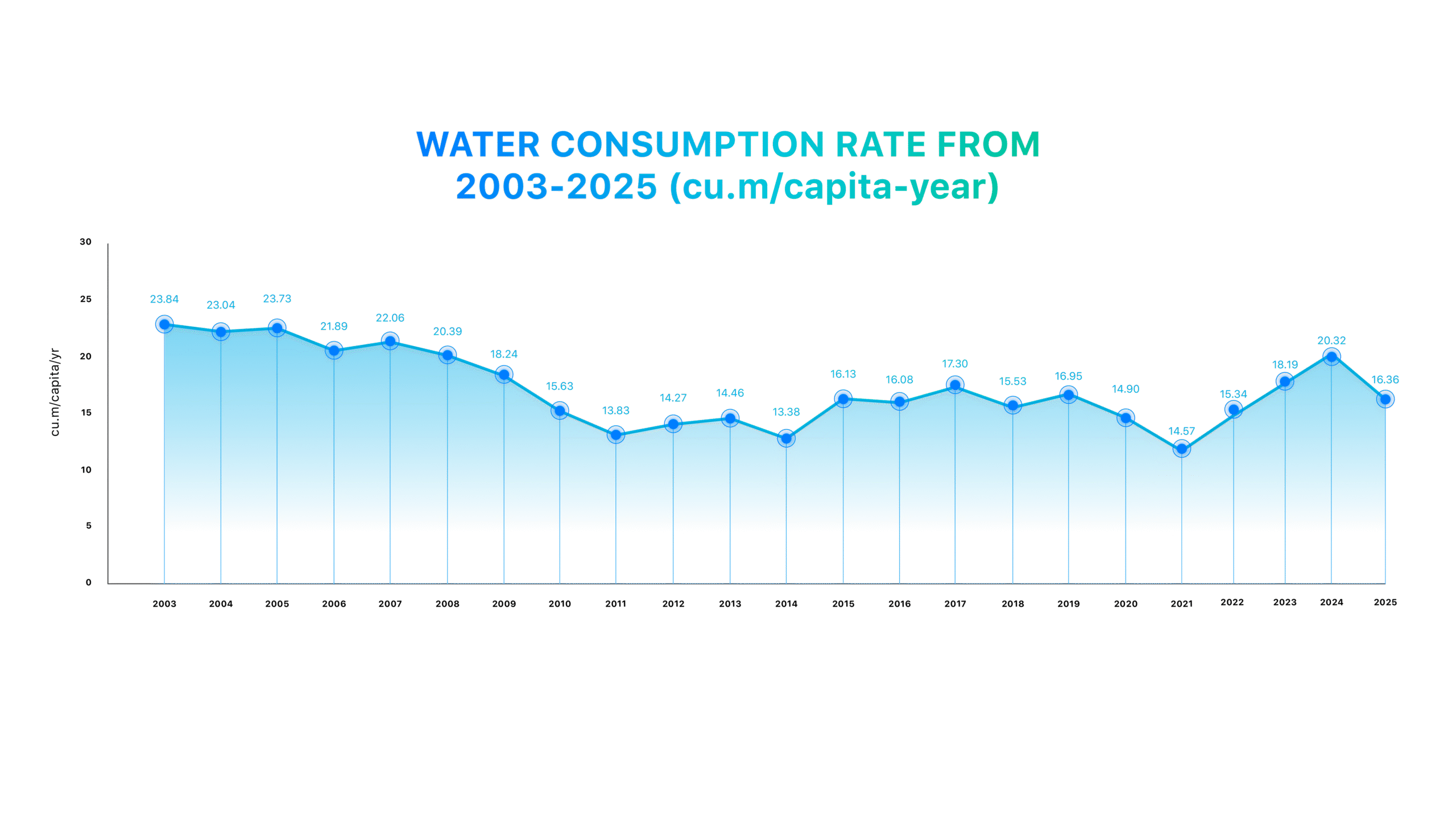 The reduction in per capita water consumption at KMUTT is due to several proactive strategies and projects focused on sustainable water management. The university has implemented comprehensive water conservation measures, including water-saving campaigns to raise awareness among students, faculty, and staff about the importance of reducing water consumption.
The reduction in per capita water consumption at KMUTT is due to several proactive strategies and projects focused on sustainable water management. The university has implemented comprehensive water conservation measures, including water-saving campaigns to raise awareness among students, faculty, and staff about the importance of reducing water consumption.
Furthermore, KMUTT has installed automatic water sensor devices across the campus, particularly in toilets and washbasins. These sensors detect motion and dispense water only when needed, thereby preventing wastage. By automating water flow, KMUTT ensures that water is used efficiently, even during peak hours, without compromising convenience. This technology-driven solution has contributed significantly to the university’s goal of reducing unnecessary water consumption.
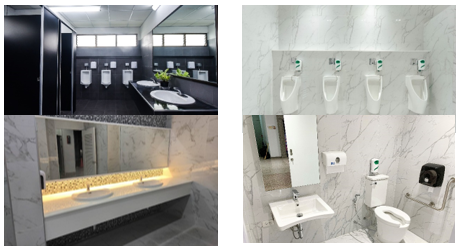
Furthermore, at Ratchaburi campus, 100 percentage of water consume within campus is came from their own portable water plant with production capacity at 5 m3/hr. Rainwater harvesting is the main source for production in order to consume from tap water of Metropolitan Waterworks Authority. By developing water supply production and distribution standard, KMUTT create stability and sustainability in water supply within campus. The following figure present the flow chart of portable water plant process.
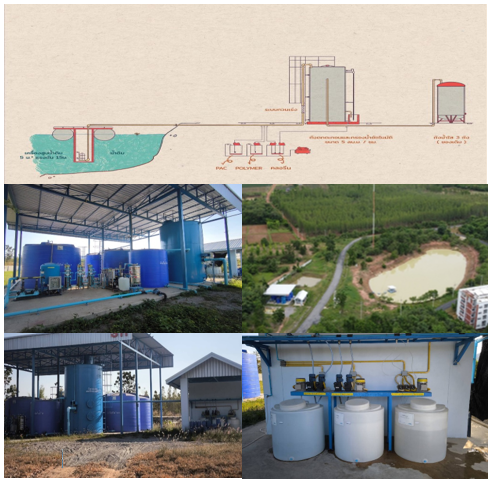
6.3 WATER USAGE AND CARE
1. Related information on our university as a body having a process in place to treat waste water.






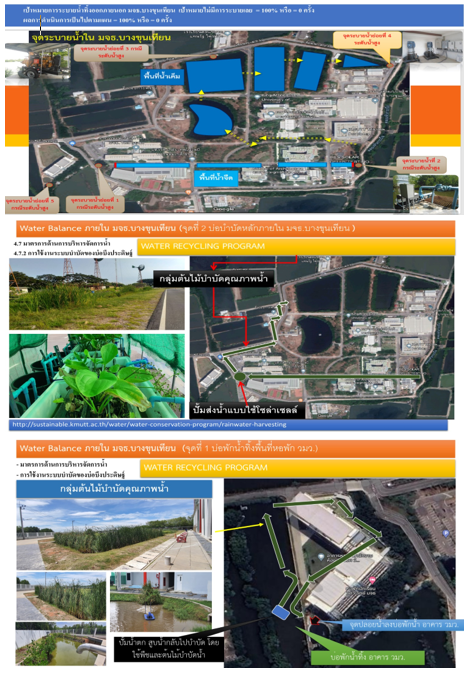
2. Related information on our university as a body having processes to prevent polluted water entering the water system, including pollution caused by accidents and incidents at the university.
KMUTT recognizes the environmental risks associated with the discharge of treated water into natural water bodies and is committed to minimizing these impacts. To ensure safe water quality, KMUTT regularly monitors treated water before it is released into public water sources. Water discharged off campus is subject to monthly and quarterly quality checks across the campus, with water samples collected from buildings and pumping stations and measurements of parameters such as pH, suspended solids (SS), biochemical oxygen demand (BOD), total Kjeldahl nitrogen (TKN), chemical oxygen demand (COD), fats, oils, and grease, as well as heavy metals such as arsenic, mercury, cadmium, and chromium.


KMUTT has established a strict and continuous waste and hazardous waste management system within the laboratory. This system involves meticulous procedures for the management, storage and disposal of hazardous substances through certified companies, along with regular training and strict procedures to ensure that all laboratory activities comply with laboratory safety standards. This practice prevents the risk of chemical contamination in wastewater that may be discharged into public water sources.

water sparingly, such as developing water sources and recycling water. Campus Water Balance: Water Recycling and bio-ecological drainage system. A sustainable water balance is defined by the AWS (2014) as “The state when the amount and timing of water use, including whether the volumes withdrawn, consumed, diverted, and returned at the site and in the watershed, are sustainable relative to renewable water supplies and are maintaining environmental flow regimes and renewable aquifer levels. Water balance has become a tool for managing water resources and a tool for protecting and maintaining the ecosystem of an environment. Managing accurate water balance assessment is necessary for short-term and long-term water resource management.
To use the university campus as a living lab for water sustainability, KMUTT has implemented a water balance system at the Bang Khun Thian campus to support teaching and research. This system consists of four main steps: prevention of wastewater from entering the campus water system, aerobic wastewater treatment, a water recycling program, and a bio-ecological drainage system using a constructed wetland. For balanced water management, wastewater from all buildings on the KMUTT Bang Khun Thian campus is treated using an anaerobic wastewater treatment plant. This is followed by water recycling, with solar-powered pumps transferring water to an artificial reservoir pond. A bio-ecological drainage system, utilizing a constructed wetland, is used to remove pollutants and reduce peak flow. Water balance analysis is conducted with monthly checks, showing that the system helps manage water resources effectively and emphasizes the need to control water quality to meet standards. The water balance system aligns with SDG 6, which focuses on sustainable water management, and also supports other SDGs, including SDG 7, and SDG 11, taking action against climate change impacts (SDG 13), and stopping biodiversity loss (SDG 15).

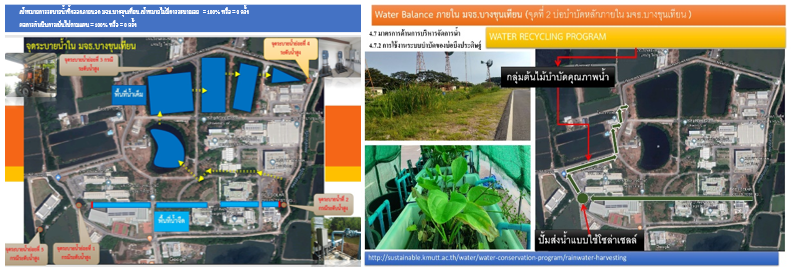
3. Related information on our university as a body providing free drinking water for students, staff and visitors, e.g. drinking water fountains).
KMUTT has over 175 free drinking water service points throughout the university, including common areas such as meeting rooms, cafeterias, and libraries, to provide students, staff, and visitors with convenient access to clean water. The water filtration system uses a combination of activated carbon, UF membranes and UV filters to ensure that contaminants are effectively removed from tap water.

The activated carbon filter removes chlorine, sediment, volatile organic compounds (VOCs) and other contaminants, improving the taste and odor of the water. The ultrafiltration (UF) membrane adds another layer of filtration, effectively blocking some large-suspended particles, bacteria and viruses. The small pores of the UF membrane allow water molecules to pass through while trapping particles as small as 0.01 microns, further enhancing the purity and safety of the water. This layer of filtration is particularly useful in capturing any remaining microorganisms and contaminants that may not be absorbed by the activated carbon filter. At the same time, the UV filter sterilizes the water, inactivating any remaining bacteria, viruses or microbes, ensuring that the water is free from harmful pathogens. These filtration steps work together to create a comprehensive water purification process, resulting in high-quality drinking water throughout the university.

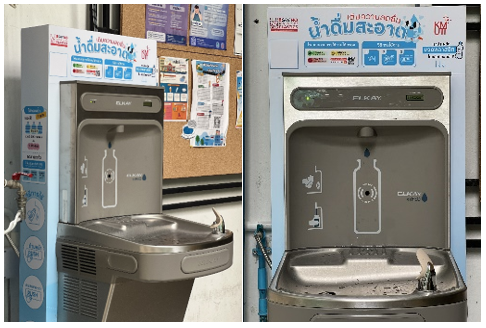
To maintain water quality, all water purifiers undergo monthly maintenance and checks, which include inspecting filters, cleaning units, and verifying performance. Additionally, the filters are replaced every six months to ensure the system continues to operate effectively and provide safe drinking water for students, staff, and visitors
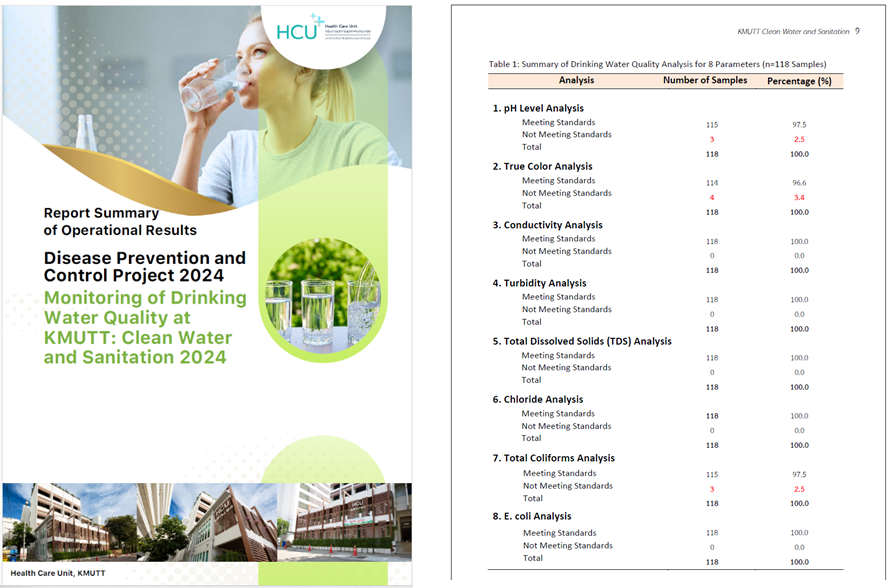
4. Related information on our university as a body on applying building standards to minimise water use.
KMUTT is committed to water conservation, aiming to reduce water usage by 30% by 2030 compared to 2006 levels, in alignment with the Thailand Energy Efficiency Development Plan. As part of this effort, all high-water-use urinals and faucets have been upgraded with motion sensor valves, which automatically shut off after each use, significantly reducing water waste. Additionally, KMUTT’s procurement guidelines mandate that all water-using appliances must carry a green certification or eco-label, ensuring the purchase of environmentally friendly options that support water conservation goals.

Automatic faucets & Sensor urinal & Highly efficient toilet flush
| Sanitary ware type | Total Number | Total number water Efficient appliances | Percentage |
| TAP | 1,433 | 1,433 | 100 % |
| flush valve | 803 | 803 | 100 % |
| Sanitary ware | 3,702 | 3,702 | 100 % |
| Average Percentage | 100 % | ||
5. Related information on our university as a body having plant landscapes to minimise water usage.
KMUTT plans to incorporate drought-tolerant plants in the landscaping of various areas around the campus. Each planting area will feature different species of drought-tolerant plants that can thrive outdoors with minimal watering. These plants include bougainvillea, dragon tongue tree, needle tree, Hokkien tea tree, oleander tree, mok koson tree, and others.

In addition, plants that thrive in wet conditions are selected for planting in the rainwater collection area. These plants are suitable for environments with high water retention. When planted in the rainwater collection area, which significantly reduces the amount of tap water used. These plants also play a key role in improving water quality through natural filtration processes. Their root systems also help stabilize soil, prevent soil erosion, and help make water management systems more sustainable and efficient.
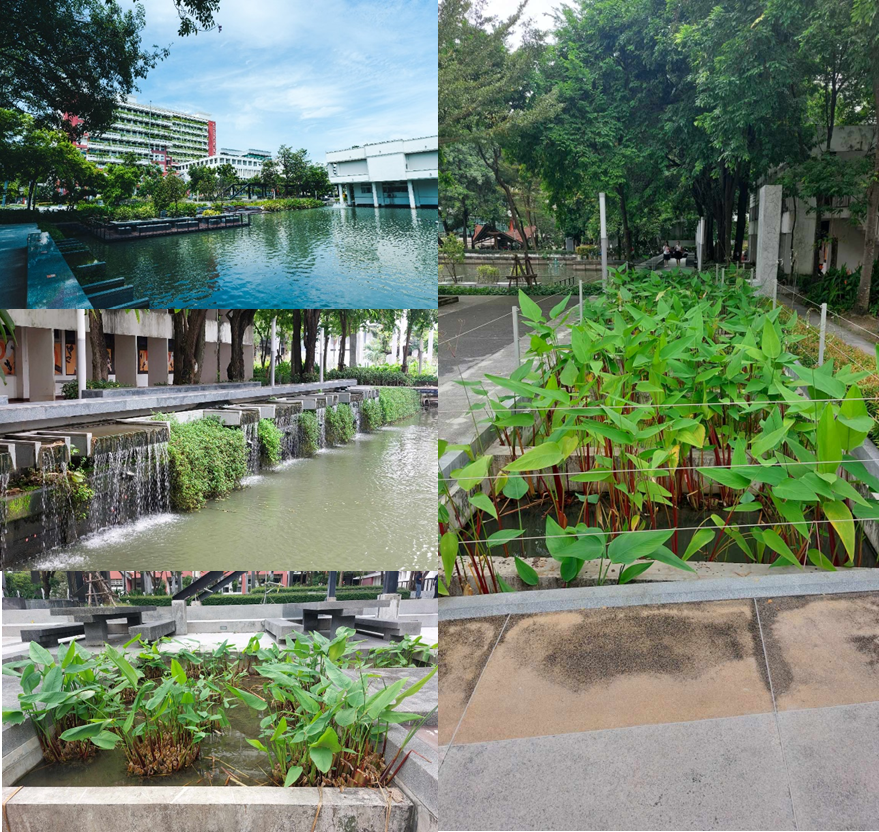
KMUTT also use a drip irrigation system to help water the plants. high-rise buildings by a drip system It is a method of irrigation technology is to give water to plants by sending water through a pipe system and releasing water through the drip head. which is installed at the base of the plant Water will drip slowly down the roots. Regularly at a rate of 4-20 liters / hour at a pressure of 0.3-2 bar, depending on the system, plant type, area size and soil type. The key to this type of irrigation is to maintain soil moisture levels. The root area of the plant to a level that the plant roots can easily absorb. Create perfect growth, suitable and meet the needs of plants. As a result, plants grow more efficiently and save more water than all methods. Either by hand or sprinkler and can also provide water soluble fertilizer at the same time It also saves work time as well.
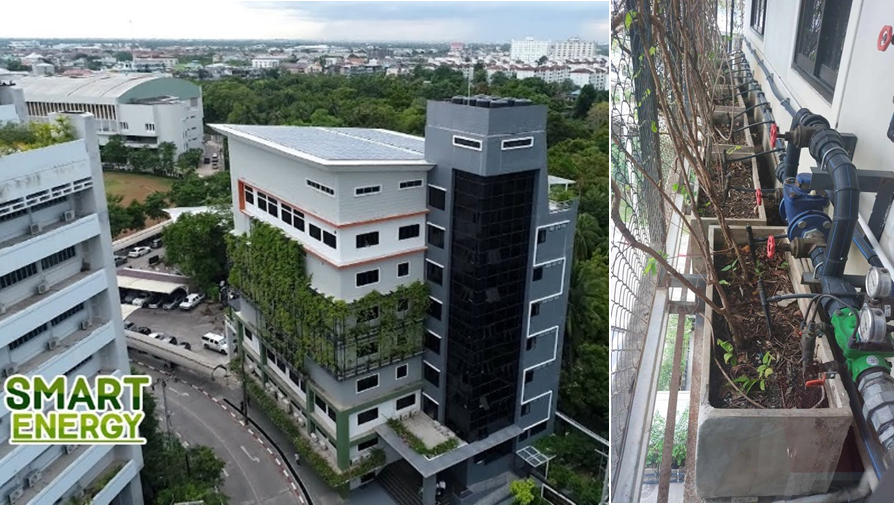
6.4 WATER REUSE
1. Related information on our university as a body having a policy to maximise water reuse across the university.
- Work with our communities to develop awareness of “why” and “how” we should reduce our water consumption.
- Reduce water usage per person 30 % by 2030 compared to the 2003 baseline.
- Increase Rainwater/ Open Natural Water Resource usage 20 % by 2020.
- Increase water recycling program from sanitary and reuse water usage in the campus by 25 % in 2023 compared to 2018.
- Achieve safe drinking water and clean wastewater campus-wide by 2023.
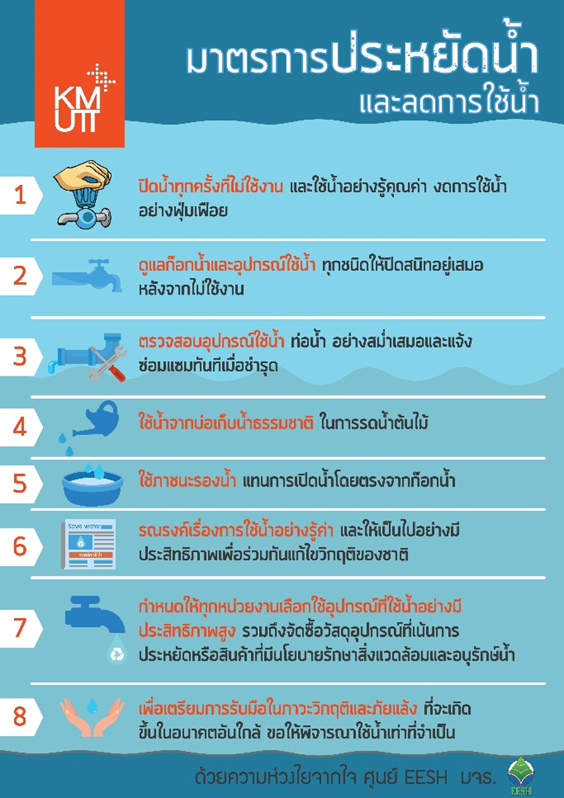
(Figure Caption No 1: Announcement of Water Saving )
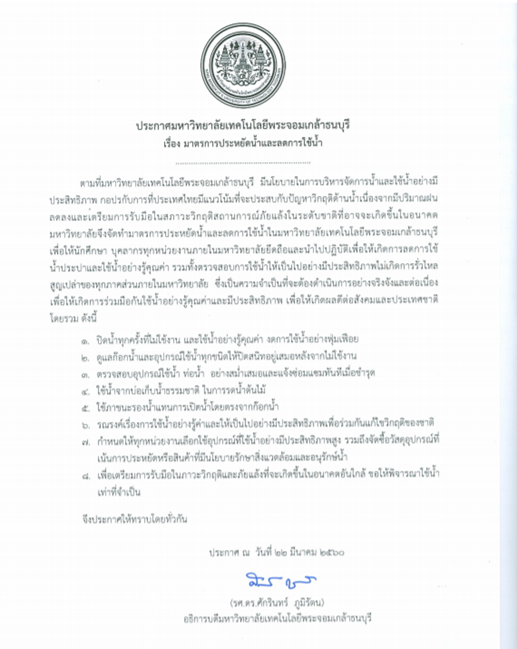
(Figure Caption No 1: Announcement of Water Saving )
KMUTT has established water conservation measures to be applied across all campuses for sustainable water management, focusing on efficient water use and reducing waste. The water conservation measures at KMUTT include:
1) Turn off faucets when not in use and use water responsibly to avoid waste.
2) Ensure all faucets and water-using equipment are completely closed after use.
3) Regularly check water-using equipment and pipes and promptly report any damage.
4) Water plants using water from natural reservoirs.
5) Use containers to collect water instead of running it directly from the faucet.
6) Campaign for the wise and efficient use of water to tackle the national water crisis.
7) Purchase devices that prioritize water conservation and environmental sustainability.
8) Use water only when necessary to help prepare for potential droughts.
2. Related information on our university as a body on measurement the reuse of water across the university.

The charts compare the implementation of water recycling process in conventional and Green building in the years 2005 and 2021. Between these years, water–recycling program nearly 100 percent completely install, improving and developing from throwing precious water down the drain to recycle water around campus. In 2005, only wastewater treatment plant is operated to treated waste water before discharge back to community. On that time, most of activities such as gardening, road cleaning and toilet flushing are only use water from tap water. By 2010, KMUTT more seriously concern on water conservation and sustainable water management which aim to both minimizes the effects of drought and water shortages and makes water available for recreational purposes. Thereby, green building with water recycling system is operated. By water recycling program implementation, it produced largely impact to the reduction of water consumption and water bill. Overall, it is clear by 2030 the Implemention of water recycling program within KMUTT would be 100%
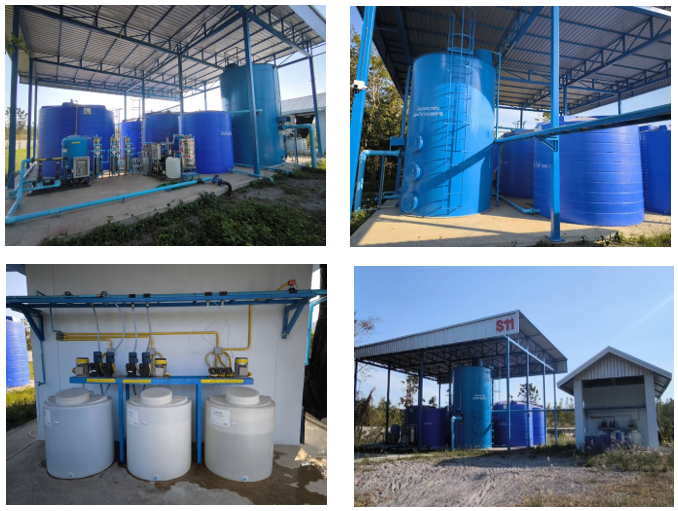
(Fig.2 : Water Production system)

(Fig.3: Water Recycling Program at KMUTT)
At KMUTT, Grey water and black water are totally separated from wastewater treatment process. Wastewater from baths, sinks, washing machines and other kitchen appliances are defined as grey water whereas wastewater from toilets, which likely contains pathogens is defined as blackwater. For water recycling program in campus, greywater is take in recycling schemes. These recycled water is used for nonportable (not for drinking) purposes within campus such as gardening, toilet flushing, floor cleaning, bike cleaning and construction activities i.e. concrete mixing. By recycling water, campus could reduce the volume of water used in each activities up to 65,000 m3/year. The following figures present the implementation of water recycling program of KMUTT:

Fig.4: recycled water is used for gardening
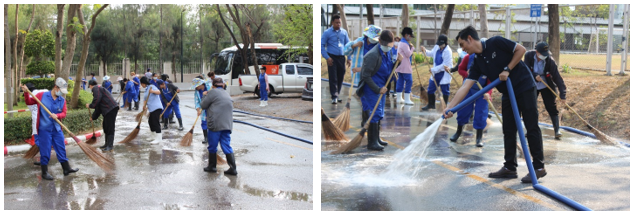
Fig.5: recycled water is used for floor cleaning
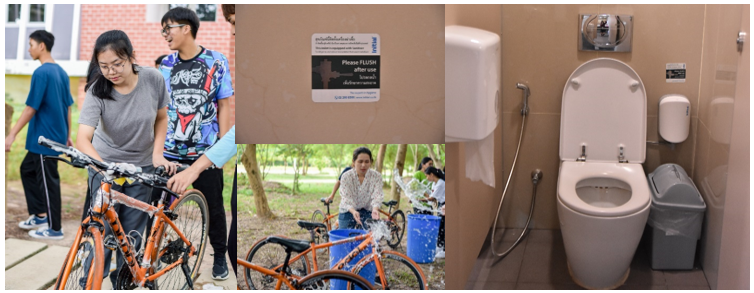
Fig.6: recycled water is used for cleaning
6.5 WATER IN THE COMMUNITY
1. Related information on our university as a body providing educational opportunities for local communities to learn about good water management.
KMUTT offers opportunities for the public, students, and nearby communities to visit the university and engage in learning activities focused on water management, particularly in coastal resource management and sustainable mangrove conservation. Through these programs, students, staff, and community members gain insights into efficient water management practices, including the conservation and restoration of water resources to ensure sustainable, long-term use. These initiatives also address challenges related to water resource quantity and quality.

KMUTT organizes mangrove planting activities by inviting students, personnel, and local communities to participate in water resource conservation so that participants can directly experience the importance of mangrove forests in coastal ecosystems. These activities will help strengthen the relationship between KMUTT and surrounding communities. Mangroves serve as natural barriers that protect coastlines from erosion and buffer against the impacts of storms and rising sea levels. Restoring and expanding mangrove forests also helps to absorb carbon, playing a vital role in addressing climate change. In addition, mangroves offer critical breeding grounds and habitats for a diverse range of aquatic species, birds, and other wildlife, enhancing biodiversity. They also support local communities by providing potential future food sources and sustaining ecosystems.

Open House 2024 at KMUTT offers high school students and interested parties the opportunity to explore career paths in environmental engineering and learn about water management. The Department of Environmental Engineering offers in-depth presentations on these aspects of water management: Coagulation Water Treatment, Adsorption Water Color Removal, what is the Quality of Water We Use, and Wastewater Treatment Models. This will provide high school students with real-world experience and a deeper understanding of the important role of effective water management in society, from pollution control to sustainable resource management.

In August 2024, the Environmental Technology Program, Faculty of Energy, Environment, and Materials, organized a special hybrid lecture on “Nanobubble Technology Applications in Environmental Remediation and Agriculture” by the speaker, Prof. Samir Kumar Khanal from the Department of Molecular Biosciences and Bioengineering, University of Hawai’i at Manoa, United States. This lecture aimed to provide knowledge to master’s and doctoral students of the program, researchers, and the general public about the application of nanobubble technology in the treatment of environmental pollutants and agricultural applications.
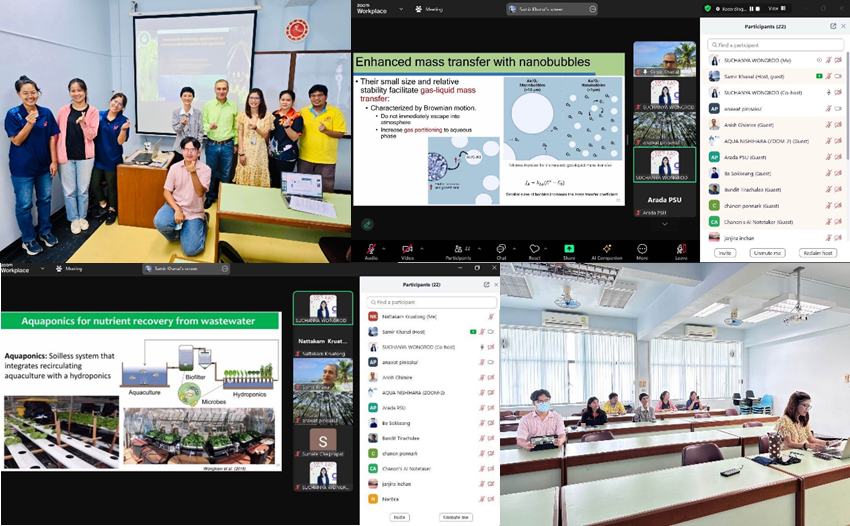
3. Related information on our university as a body supporting water conservation off campus.
KMUTT regularly organizes mangrove planting activities and on important occasions. These activities bring together students, university staff, and both government and private sectors to conserve and restore natural resources, which is part of KMUTT’s environmental commitment in a new area in Phanthai Norasing Sub District, Mueang District, Samut Sakhon Province.
Mangrove forests play a vital role in water conservation and coastal protection. Their dense root systems stabilize coastlines by reducing erosion and slowing down the impact of waves and storm surges, which helps prevent seawater from intruding into freshwater sources. Acting as natural filters, mangroves trap sediments and pollutants, improving water quality and preserving freshwater for surrounding ecosystems and communities. Additionally, these forests reduce flood risks by absorbing and slowing floodwaters, which protects inland water sources from contamination. Mangroves also support groundwater recharge by slowing surface runoff and allowing water to percolate into the ground, replenishing critical aquifers.

KMUTT led by the Office of Physical Resources Management KMUTT Bangkhuntien (Bang Khun Thian Police Station) and the Energy, Environment, Safety and Occupational Health Management Center (EESH Center) participated in the volunteer project “We do good deeds with the heart” to plant mangrove forests. And release aquatic species On the auspicious occasion of her 90th birthday, August 12, Her Majesty Queen Sirikit Her Majesty the Queen The Queen Mother to honor and show Pol Lt. Gen. Samran Nuanma, Commander-in-Chief of the Royal Thai Air Force, presided over the opening ceremony. along with government agencies Police officials, PD.N.9, KMUTT personnel, students, and community leaders A total of 400 volunteers and people joined together to plant mangrove forests and release aquatic species at the Bang Khun Thian Mangrove Forest Learning Center. loyalty and appreciation who performed various royal duties for the benefit and happiness of the people The said activities also encourage participants to study and learn about royal initiatives on conservation and restoration of natural resources and the environment. cherish love including taking part in the conservation and restoration of national resources which is currently in deteriorated condition to return to perfection and the balance of the ecosystem.

KMUTT has developed a “solar-powered water quality monitoring and warning buoy” in the Bangmod Canal area, reflecting the support for water conservation in communities surrounding the university. By using appropriate technology for the area, farmers can monitor and be aware of the saltwater situation in real time, which enables efficient water usage planning, such as storing freshwater to prevent saltwater intrusion. The use of this buoy reduces the dependence on tap water for agriculture and helps manage water resources sustainably. In addition, the data obtained from the buoy can be analyzed and used in planning future water management, both at the community level and for related agencies. This development is an example of cooperation between educational institutions and communities to strengthen water conservation and water resource management in areas outside the university.

KMUTT joins hands with GC and Map Ta Phut Municipality to use underground water banks to help mango farmers in Rayong Province prevent flooding and store water for use during the dry season
Dr. Pariwet explained that groundwater management or underground water banking is the process of adding rainwater to increase the amount of groundwater in aquifers during the rainy season. To reduce the impact of flooding in the area, during the dry season, water from surface wells and nearby artesian wells can be used. This groundwater management not only helps slow flooding and retain water during the dry season, but also reduces salinity and increases soil moisture in mango orchards in Map Ta Phut Municipality, Mueang District, Rayong Province.
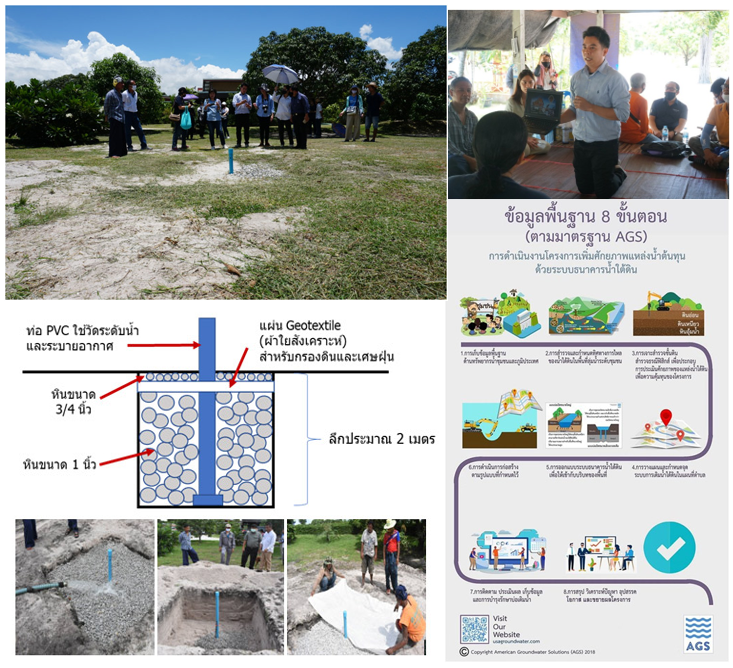
4. Related information on our university as a body utilizing sustainable water extraction technologies on associated university grounds off campus.
KMUTT has introduced an innovative solar-powered water pumping and aeration system to replace the conventional oil or electricity-powered systems. The solar technology significantly reduces energy costs and minimizes pollution, making it an effective example of clean energy use integrated with sustainable water management. Designed to operate within an artificial reservoir, the solar-powered system efficiently aerates the water, enhancing oxygen levels essential for aquatic life and water quality. Additionally, it pumps and circulates water from the reservoir to support other uses across the campus, ensuring a continuous and renewable supply. By utilizing solar power, KMUTT’s system not only reduces environmental impact but also promotes a sustainable approach to managing water resources, benefiting both the ecosystem and the university’s operational efficiency.

In addition, KMUTT has incorporated Internet of Things (IoT) technology into the solar-powered water pumping and aeration system, allowing for remote monitoring and control via a mobile app. This feature enables users to easily schedule and automate the system’s on/off cycles, making water management more convenient and efficient. The system will be installed at KMUTT’s Solar Cell Learning Base and Water Management Center in Chanthaburi Province, specifically supporting applications in line with the principles of the “New Theory Agriculture” model. This initiative expands the reach of clean technology and advanced water management solutions to regions outside traditional irrigation zones, where water resources are often limited and require optimized distribution. The IoT-enabled automation not only enhances water management efficiency but also significantly reduces labor requirements, empowering local farmers and communities with a reliable and sustainable system for crop irrigation and water conservation.
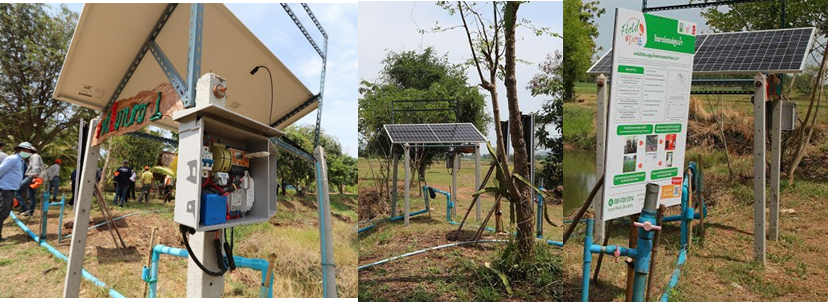
At KMUTT, Grey water and black water are totally separated from wastewater treatment process. Wastewater from baths, sinks, washing machines and other kitchen appliances are defined as grey water whereas wastewater from toilets, which likely contains pathogens is defined as blackwater. For water recycling program in campus, greywater is take in recycling schemes. These recycled water is used for nonportable (not for drinking) purposes within campus such as gardening, toilet flushing, floor cleaning, bike cleaning and construction activities i.e. concrete mixing. By recycling water, campus could reduce the volume of water used in each activities up to 65,000 m3/year. The following figures present the implementation of water recycling program of KMUTT:

Furthermore, at the Ratchaburi campus, 100% of the water consumed within the campus is produced by its own potable water plant, which has a production capacity of 5 m³ per hour. Rainwater harvesting serves as the main water source for production, thereby reducing dependence on tap water supplied by the Metropolitan Waterworks Authority. By developing standardized systems for water production and distribution, KMUTT has established a stable and sustainable water supply within the campus. The following figure presents the flow chart of the potable water plant process.
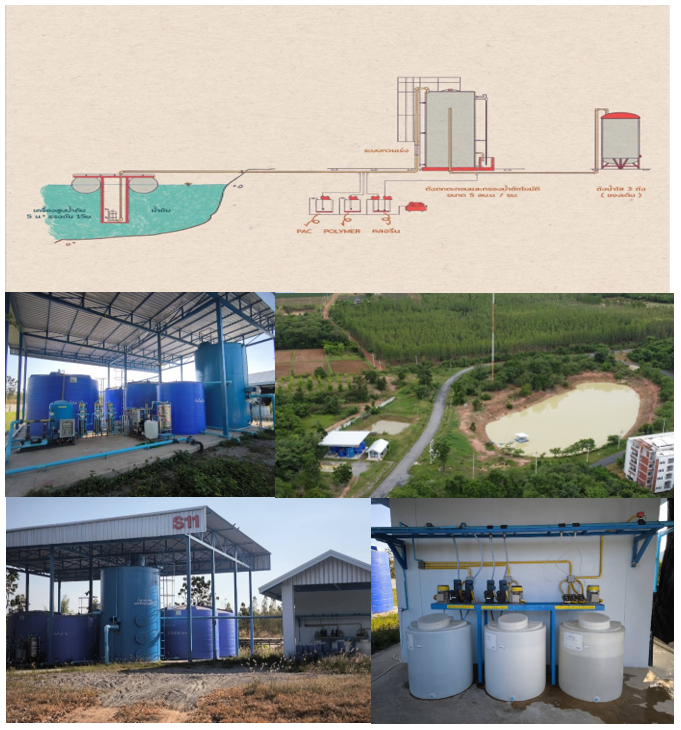
5. Related information on our university as a body on cooperation with local, regional, national or global governments on water security.
In collaboration with the Thungkhru district office and neighboring communities, King Mongkut’s University of Technology Thonburi (KMUTT) actively participates in off-campus water conservation initiatives and educational programs to foster awareness and engagement between the university and the surrounding communities. Each month, KMUTT volunteer students dedicate their time to cleaning local canals, focusing on the removal of plastic waste and other debris. This collected waste is then transported to KMUTT’s waste bank, where it is processed and managed responsibly, reducing environmental impact and contributing to a cleaner, healthier community environment.
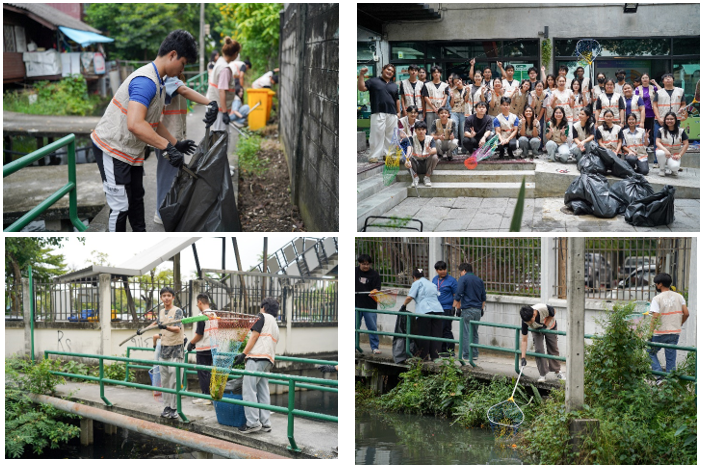
KMUTT has been one of the 3C Project (Cycling – Canal – Community) projects to develop a canal area into a bicycle path. To create a sustainable travel and community economy Born from the gathering of communities, people who love the city, love bicycles, love canal, want to see sustainable community development. Creating alternatives for a healthy society Prosperous economy and beautiful environment with the distinctiveness of life along the canal creating accessibility opportunities by connecting bicycle paths along the canal to access the train stations creating accessibility opportunities by connecting bicycle paths along the canal to access the train stations giving the community a choice in how to travel to school Go to work without relying on a car, creating health and not polluting the air and noise for foreigners. There are travel options. Exchange and learn about the riverside lifestyle Shopping at the shops along the canal Promote a strong community economy housekeeping Bring the farms and water sources back to life. With this idea, a prototype project of a bicycle path along the Bang Mod canal was pushed.
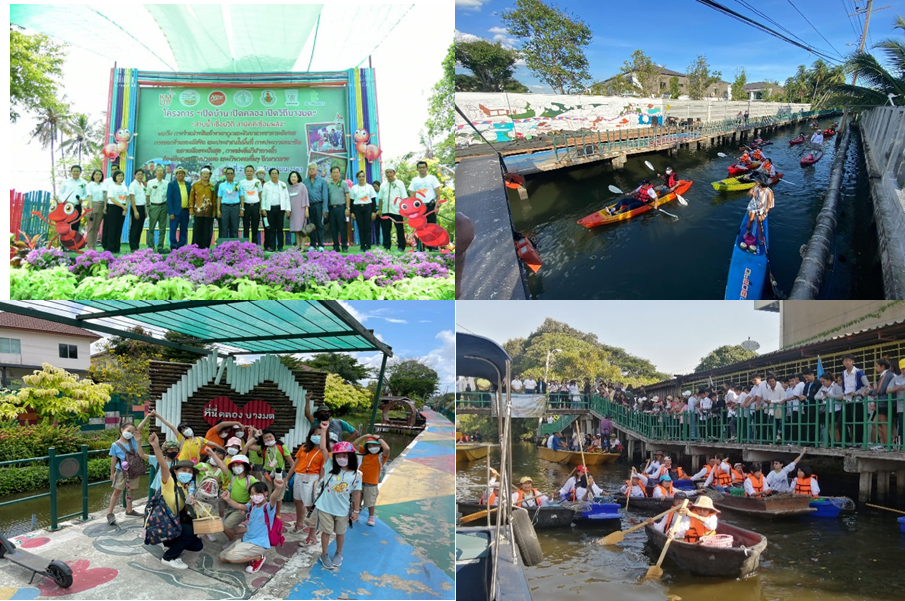
The Community and Circular Economy Research Group (EEC&C Research Group) from KMUTT, together with Assoc. Prof. Dr. Samir K. Kanal from the Department of Molecular Biosciences and Bioengineering, University of Hawaii at Manoa, USA, and Rajamangala University of Technology Lanna, visited and provided consultation on KMUTT’s upland fish farming project, located in a watershed mountain range. The project is designed to improve aquaculture and water resource management. This collaborative effort demonstrates KMUTT’s commitment to working with local and regional partners to promote sustainable water security practices by strengthening relationships with government agencies at various levels, from local to global.
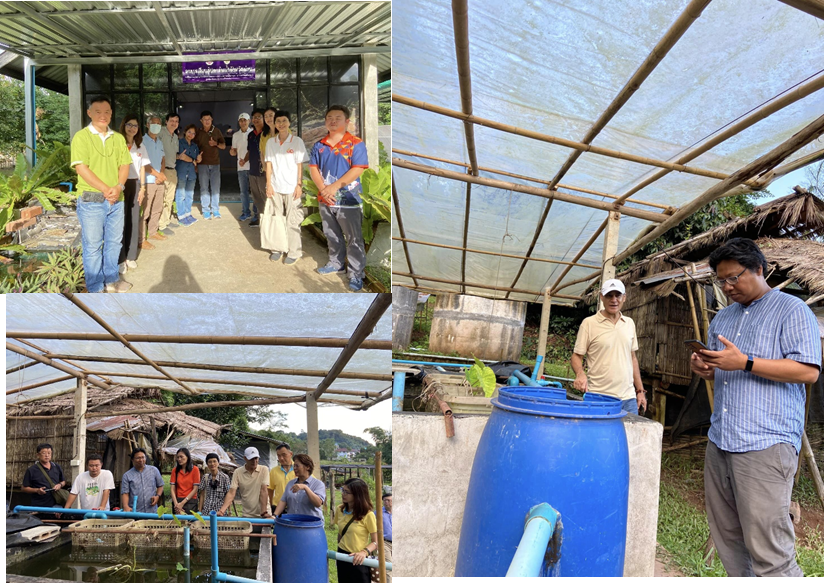
KMUTT academics recommend analyzing and examining the potential of underground water sources according to AGS standards before establishing an underground water bank for maximum benefit
The principle of underground banks is to add water to store underground and then retrieve it when needed. King Mongkut’s University of Technology Thonburi (KMUTT) has participated in using knowledge in geographic information systems (GIS) by participating in the project until now, which is the third year. Dr. Pariwet Wannakowit, Head of the Center for Geo-Informatics and Innovation Engineering (KGEO) and Lecturer in the Department of Mathematics, Faculty of Science, King Mongkut’s University of Technology Thonburi (KMUTT). KMUTT’s responsibility is to utilize academic knowledge in geographic information systems (GIS) and satellite image interpretation to gather data to identify areas for the establishment of underground water banks because each area has different soil and aquifer characteristics. The project began operations in 2017. Prototype areas already participating include Ban Phueng Subdistrict, Nakhon Phanom Province; Wang Ham Hae Subdistrict, Kamphaeng Phet Province; Nong Mamong Subdistrict, Chainat Province; and Chiang Khruea Subdistrict, Sakon Nakhon Province. Ban Phueng Subdistrict, in particular, is considered a model for sustainable groundwater management to address local drought issues. Villagers have access to drinking water throughout the year

6. Promoting conscious water usage on campus
Promoting conscious water usage on campus is a vital component of KMUTT’s commitment to sustainability and environmental stewardship. Raising awareness about water conservation empowers students, faculty, and staff to understand the far-reaching impacts of their daily actions and fosters a collaborative effort to minimize water waste. Through comprehensive guidelines and resources, KMUTT encourages the community to incorporate simple, effective practices into their routines, such as promptly reporting leaks, using water-efficient appliances, and adopting mindful habits around water use. The University actively communicates best practices and detailed instructions to ensure water is used efficiently and responsibly across campus facilities.

In addition, KMUTT has consistently organized initiatives to promote responsible water use through campaigns and activities aimed at staff, students, and faculty. These efforts are designed to integrate sustainable water use into the University’s daily operations and culture, and create awareness about the value of water. The University emphasizes shared responsibility and proactive attitudes toward water conservation, aiming to reduce tap water consumption across campus and encourage a strong commitment to sustainable water resource management.
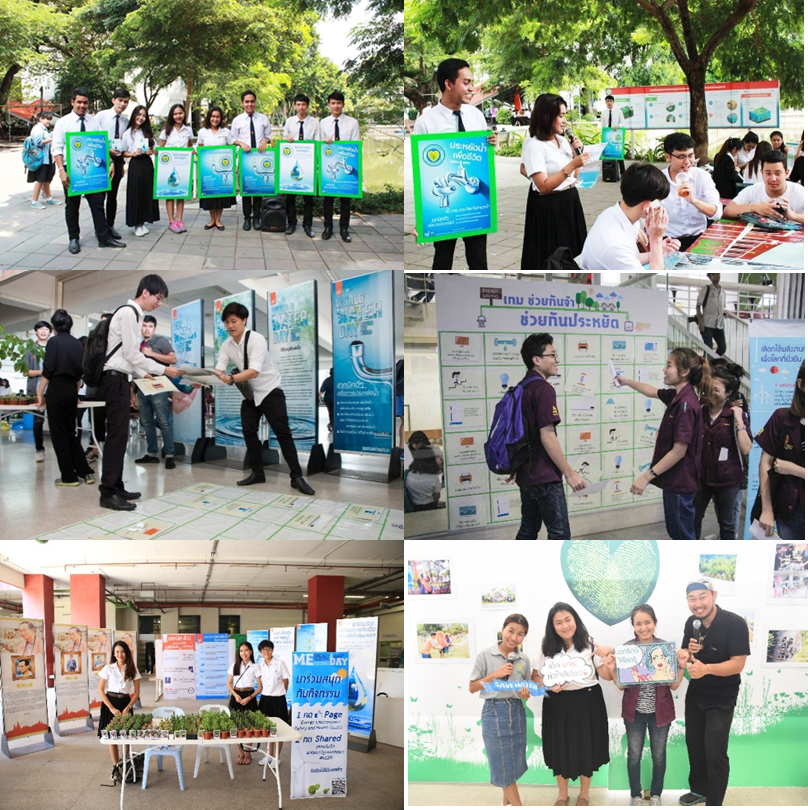
7. Promoting conscious water usage in the wider community
KMUTT, led by EESH Center, together with the Green Heart Team student leaders, organized an activity to provide knowledge and create school leaders for students and teachers of Supitcha School, totaling more than 60 people, to support the creation of a green society and enhance sustainable social health under the KMUTT Green School Network training project, which is a network of green schools. The activity is an activity that creates an integration of activities, instills awareness of waste separation and good energy conservation in line with government policies for children and youth, to expand environmental management to schools, create student leaders who are aware of energy conservation, the environment, and safety (Green Heart), as well as disseminate and expand the impact on families, communities, and society, while supporting the creation of sustainable healthy cities.
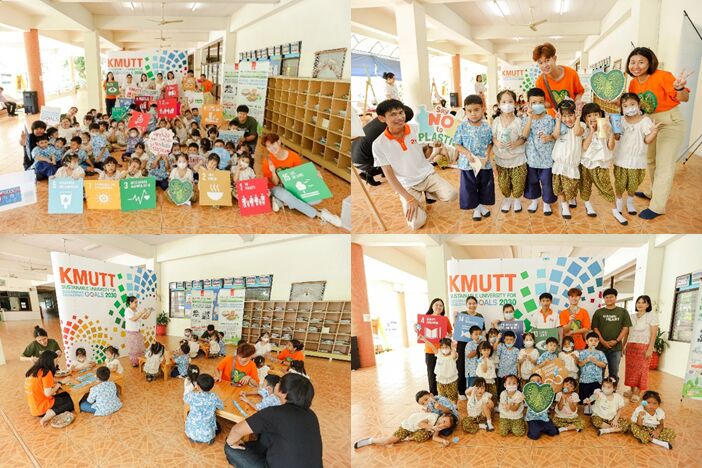
KMUTT has organized Green Heart Camp Online, an online camp to learn about sustainability, energy, environment, and safety. Study + play in a new way through online channels (ZOOM program), with over 62 elders giving knowledge in various fields. To create awareness and understanding of the university’s policy towards sustainability and is the starting point of organizing activities to create student leaders to be a leader of change in the future, Change Agent and have a Green Heart, including organizing green School network activities which will have students who are volunteers Come join the leader in activities to expand knowledge and understanding of energy conservation, environment, safety. Pay attention to health and reduce global warming in a sustainable way, to communities, schools through teachers and students participating in the activities. which in organizing the Green Heart Camp Online In the theme of “Green School network: Green Heart Junior” under the epidemic situation of COVID-19, with the implementation of the New Normal way according to the principle of social distancing by organizing non-aggregation activities It’s the nature of the online format. via social networks focusing on activities to promote and to achieve sustainable green university activities and to promote knowledge and understanding of energy conservation, environment, safety Including learning how to protect yourself safe from COVID-19 to reduce risks and avoid COVID-19 by divided into learning-based activities for everyone to participate in every activity. More than 86 children from various schools participated in the activity.

SDG 6: Clean Water and Sanitation
Overview of Operations at King Mongkut's University of Technology Thonburi (KMUTT)
30% Reduction Target
Achieved 31.38% reduction (by 2024) using motion sensors and green procurement.
Greywater Recycling
Saves 65,000 m³/year; separated greywater used for gardening, flushing, and cleaning.
Ratchaburi Water Plant
100% of water consumed is produced on-site using rainwater harvesting as the main source.
100% Water-Efficient Ware
All 1,433 taps, 803 flush valves, and 3,702 sanitary units are water-efficient models.
Drought-Tolerant Landscaping
Uses plants like bougainvillea and drip irrigation to maintain soil moisture efficiently.
Green Procurement
Mandates green-certified or eco-labeled water-using appliances for all purchases.
Mangrove Planting
Events with students and communities to conserve water resources and coastal ecosystems.
Nanobubble Technology
Hybrid lecture on applications in environmental remediation and agriculture (Aug 2024).
Open House Demos
High school students learned about coagulation, adsorption, and wastewater treatment models.
Community Volunteer Projects
Canal cleanups with Thungkhru district and "We do good deeds" mangrove planting (400 volunteers).
Living Lab (BKT)
Water balance system with aerobic treatment, recycling, and constructed wetlands.
Solar-Powered Monitoring
Developed a water quality buoy for real-time saltwater monitoring in Bangmod Canal.
IoT Water Pumping
Solar-powered system with remote monitoring via mobile app for irrigation (Chanthaburi).
Wastewater Treatment Tech
Research on 4-step SBT MICA SAND process and activated sludge dewatering.
Toxin Removal Plant
Treats cyanide and heavy metals like arsenic, lead, mercury, and cadmium.
Groundwater Banking
Uses GIS for site identification in collaboration with multiple provinces (e.g., Nakhon Phanom).
31.38% Per Capita Reduction
Exceeded the 30% reduction target by 2024 (vs. 2003 baseline).
Wastewater Compliance
96% of wastewater treated to compliance (+3%), with a 23% non-potable reuse share (+5%).
175+ Free Drinking Points
Purified via activated carbon, UF membranes, and UV filters; maintained monthly.
86 L/person·day
Daily water use per capita (a 7% reduction), showing efficient consumption.
Off-Campus Impact
Underground water banking project in Rayong helps mango farmers prevent flooding.
Water Conservation
A commitment to reduce water consumption, increase recycling, and ensure safe drinking water on campus.
Waste Management
Manages both municipal and hazardous waste according to the waste hierarchy to ensure responsible disposal.
Biodiversity Promotion
Aims to mitigate negative environmental impacts, including the control of wastewater and other pollutants.
Sustainable Green University
An overarching policy to lead in sustainability, including responsible energy, environment, and safety management.

